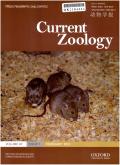时间和地点会影响青蛙广告叫声的声学结构
IF 2
2区 生物学
Q2 ZOOLOGY
引用次数: 0
摘要
在许多类群中,声学通讯信号对于物种识别和配偶吸引非常重要。例如,在数以千计的蛙类物种中,大多数都有一种物种特有的广告叫声,雌蛙利用这种叫声来定位和区分潜在的配偶。因此,广告叫声的声学结构对繁殖成功至关重要。随着进化时间的推移,叫声的声学结构一般会发生分化,并且会受到同域物种叫声的影响。虽然许多研究表明地理环境对当代蛙类种群的叫声变异有影响,但还没有研究比较过多个物种的蛙类叫声结构,以探究我们现在观察到的物种典型叫声的声学结构差异是否受分化时间和总体地理重叠的影响。为此,我们比较了 4 个科 225 种青蛙叫声的声学特征。此外,我们还利用一种蛙类的行为测定来确定在大规模分析中应优先考虑哪些声学特征。我们发现有证据表明,系统发育(时间)和地理(地点)都与广告叫声有关,尽管这些关系在分析的四个科中存在很大差异。总之,这些结果表明,尽管有许多生态和进化的力量影响着叫声结构,但时间和地点的广泛力量也能塑造广告叫声的各个方面。本文章由计算机程序翻译,如有差异,请以英文原文为准。
Time and place affect the acoustic structure of frog advertisement calls
Acoustic communication signals are important for species recognition and mate attraction across numerous taxa. For instance, most of the thousands of species of frogs have a species-specific advertisement call that females use to localize and discriminate among potential mates. Thus, the acoustic structure of the advertisement call is critical for reproductive success. The acoustic structure of calls will generally diverge over evolutionary time and can be influenced by the calls of sympatric species. While many studies have shown the influence of geography on contemporary call variation in populations of frogs, no study has compared the acoustic structure of frog calls across many species to ask whether we can detect an influence of divergence time and overall geographic overlap on the differences in acoustic structure of species-typical calls that we observe now. To this end, we compared acoustic features of the calls of 225 species of frogs within 4 families. Furthermore, we used a behavioral assay from one species of frog to determine which acoustic features to prioritize in our large-scale analyses. We found evidence that both phylogeny (time) and geography (place) relate to advertisement call acoustics albeit with large variation in these relationships across the four families in the analysis. Overall, these results suggest that, despite the many ecological and evolutionary forces that influence call structure, the broad forces of time and place can shape aspects of advertisement call acoustics.
求助全文
通过发布文献求助,成功后即可免费获取论文全文。
去求助
来源期刊

Current Zoology
Agricultural and Biological Sciences-Animal Science and Zoology
CiteScore
3.20
自引率
9.10%
发文量
111
审稿时长
6 weeks
期刊介绍:
About the Journal
Current Zoology (formerly Acta Zoologica Sinica, founded in 1935) is an open access, bimonthly, peer-reviewed international journal of zoology. It publishes review articles and research papers in the fields of ecology, evolution and behaviour.
Current Zoology is sponsored by Institute of Zoology, Chinese Academy of Sciences, along with the China Zoological Society.
 求助内容:
求助内容: 应助结果提醒方式:
应助结果提醒方式:


